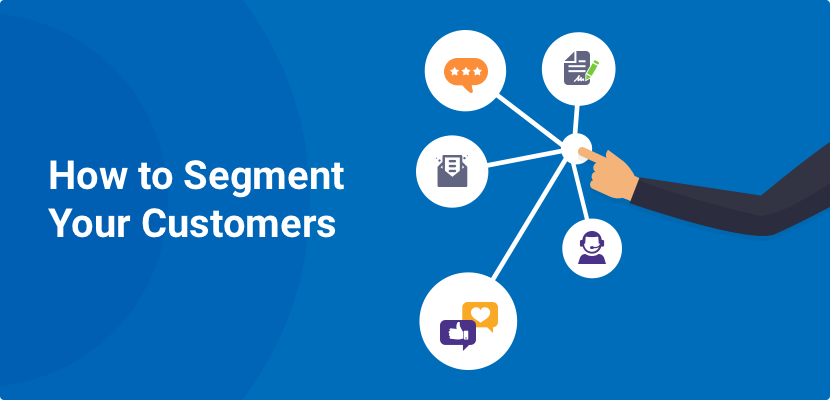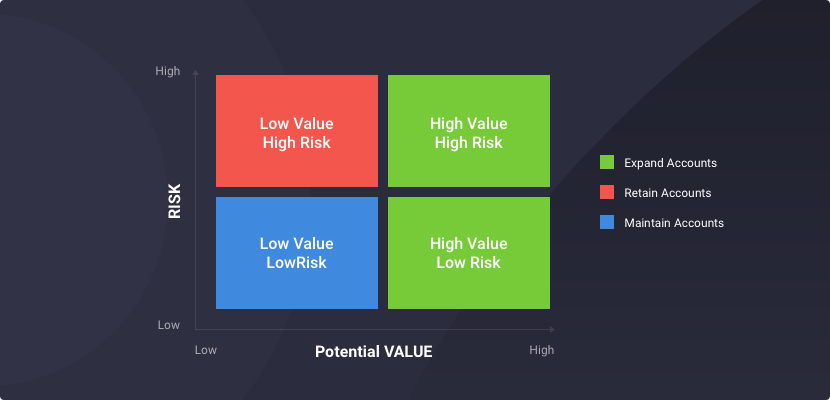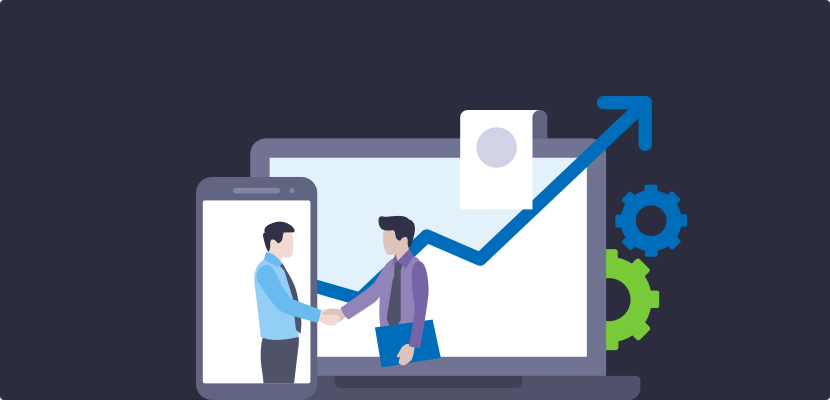It might seem strange to put your customers into groups when customer success is built on individual, personalized outreach.
Customer success managers (CSMs) are masters of one-on-one help and advice. Why would they segment their customers? The biggest reason is that it helps save time, even on individual outreach.
Today, we’ll discuss how segmentation can help customer success managers be more effective. Then we’ll look at some of the best ways to segment your customers for your CS program.

How to Use Customer Success Segmentation
Segmentation is all about tailoring messages and saving time. The same is as true for customer success as it is for marketing.
Here’s an example:
Let’s say one of your customer success managers sends out an email every week with a blog post and some industry news to a customer in the transportation industry.
Wouldn’t it be nice if you could send that same email to everyone involved in transportation? No matter which CSM is assigned?
With effective segmentation, you can. You can use your customer success software or your CRM to store segments, select the customers in a particular industry, and send the same email to them.
That will save you a lot of time.
Let’s look at another example:
You know that some customers bring in more revenue than others. And that your CSMs should prioritize working with those customers.
Wouldn’t it be great if each agent could start their day with those clients at the top of their priority list? Instead of having to search through your database to see which clients are the most valuable?
(We’ll talk about how you can get even more detailed prioritization in a moment.)
Customer segmentation will help you situations like these. There are lots of ways you can slice and dice your customer database.
Here are seven good segments to start with:
Customer Success Segmentation Metrics and Categories
1. Churn Score
One of the main functions of a customer success team is preventing churn.
Scoring and segmenting your customers by how likely they are to churn is crucial for maximizing the effectiveness of your customer success.
For example, you might have a company that hasn’t signed into your app in a week—that’s a warning sign. So the customer success agent assigned to that company can get in touch and find out how they can help.
If another company hasn’t signed into the app for three days, they might be put in a “moderate churn likelihood” category. That might only warrant a check-in email, which can be from a template (another tactic that saves time).
With these segments, your customer success agents never have to decide where to spend their time. Your segments have already answered that question.
Advanced customer success software gives you more comprehensive views of companies’ behavior. And that leads to more accurate churn scores.
You might use something as simple as the examples above, where you track login frequency. But there are other factors, too. Purchase history, engagement level, browsing behavior, and other elements can inform this metric.
2. Revenue Generation Potential
How much money are you likely to make from a customer?
This is a complicated question, and we won’t talk too much about how to answer it here. Suffice it to say that you want to have a good answer for every customer. This could take into account company size, subscription level, history, and other factors.
The point is that you should segment your customers by how much value they’re like to provide you.
Then your customer success agents make the obvious choice: to spend more time working with the clients likely to make you a lot of money.
(It may sound a bit callous; but once you grow beyond a few customers, you need to prioritize.)
As with churn potential, you’ll need to figure out the best way to create segments related to potential revenue generation.
Bonus: Account Prioritization Matrix
At the CS100 Summit in 2016, Ursula Llabres from Insidesales.com outlined an account prioritization matrix , a simple way to use churn likelihood and potential revenue to prioritize accounts.
The matrix is a simple 2x2 square, with risk on one axis and potential value on another:

This shows your CSMs which accounts they should be paying the most attention to and what their priorities should be for those accounts.
Check out Llabres’s video to hear some of the ways she and her team calculated risk and potential value to get some ideas on how you can put this matrix into action at your company.
3. Customer Age
If you’re not sure where to start with segmentation for customer success, customer age is a great candidate.
Why?
Because new customers have different needs than long-time customers.
Your new customers need help getting their accounts set up and figuring out how to maximize the utility of your product.
Customers who have been with your company longer already have that down. They’re better served by advanced tips, information on new features, and (potentially) up- and cross-selling.
This is the most basic segmentation you can do, and it’s a great place to start.
Pro tip: to get more details out of a segment like this, drill down further into lifecycle stage .
For example, it might take a large company three months to implement your product. But a smaller company could do it in one month. In this case, they’ll be put into the same category: “implementation.”
That’s true even though the customer age will be different.
4. Company Type
Many B2B vendors sell to different kinds of customers: they might have enterprise, small- or medium-sized business, and even individual customers.
These segments deserve different types of treatment.
Let’s say you’re selling software to both enterprise and individual customers. This information is relevant to your customer success team. Your agent might include interesting data and insights on usage to the enterprise customer, while focusing more on offering assistance to the individual.
In many cases, the company type will be correlated with the potential value of the client. You’re likely to make more money from an enterprise client than you are from a small business.
But these customers also require different kinds of interactions, and that’s valuable information for your CS agents.
5. Job or Role
Do you help C-suite executives in the same way that you help small business owners? Or marketing associates?
No.
And that’s a great reason to segment users based on their role. Because so many companies have different types of hierarchies, you might need to get creative with this.
You might have three categories: front-line, manager, and executive. You could get more specific and include their area, like sales or development.
This is just an example—you’ll have to come up with the categories that work best for your business (your CSMs probably already have some good ideas).
You might start with your customer success personas and build from there.
6. Customer Goal
What do customers use your product or service for? Unless you offer a highly specialized solution, they probably have different needs that they’re trying to satisfy.
Let’s say you offer production tracking software.
Some of your customers may be looking to increase their production. Others might want to keep their production numbers stable but decrease costs. Some might want up-to-the-minute data to improve their ordering efficiency.
Each of these types of customers sees different benefits in your product. And your customer success managers can help them improve the successes they’re looking for by tailoring their approach to that goal.
7. Behavioral Segmentation
As a SaaS provider, you have systems that log many types of actions taken by your customers. And you can use those actions to segment them into groups.
Here’s a simple example:
You might set up your software to flag accounts where a manager has gone to the “Unsubscribe” page but hasn’t yet unsubscribed. Now, even if that company’s churn score isn’t very high, your CS agents know that they’re at high risk for churn.
That affects how they reach out and offer help.
It could also work the other way.
If someone from the company goes to the “Upgrade” page but doesn’t choose an option, that’s a sign that they think they could get more out of your product.
Again, your customer success agents can use that information.
The possibilities for behavioral segmentation are limitless.
Amount of time spent performing a specific task could be used to segment customers. Engagement level. Indications of satisfaction and loyalty. Purchase behavior.
All of these and more can be used to create customer segments. When you start digging into behavioral segmentation, it’s easy to feel overwhelmed. Start with something basic and build up from there.
You can also start the opposite way by imagining what your ideal segment would be. Maybe it’s customers who signed up at the bronze level, but have trialled the silver level and use the app more than 10 hours per week.
With some creative segmentation, you should be able to find those customers.
Behavioral segmentation is, in a way, the opposite of the account prioritization matrix. It gives you as much detail as you want and the ability to deal with very complicated circumstances.
You may have to work with a developer to get it working. But if you know exactly who you want your CSMs to talk to, it’s worth the time you’ll spend getting it set up.
Start With the Basics and Build From There
As with many things in customer success, it’s best to start with something simple. Segmenting your customers by age or company type is easy, and will help you save time and run your customer success program more efficiently.
From there, you can build up to more complicated segments based on customer health scores & more relevant metrics like churn likelihood.
Of course, you’ll need software that supports these types of segments. Not every CRM will calculate how likely a customer is to churn (which is one reason why customer success software is so useful).
No matter where you start, though, you’ll quickly see the benefits of customer success segments. And you’ll be ready to start running a much more efficient operation.
Want more ideas on how to improve your CS program? Check out our guide to customer success best practices to build a great CS operation.




